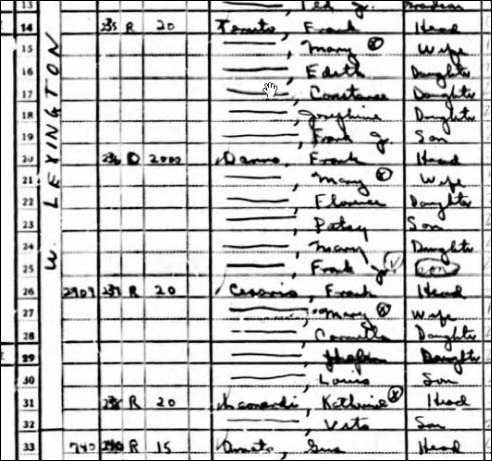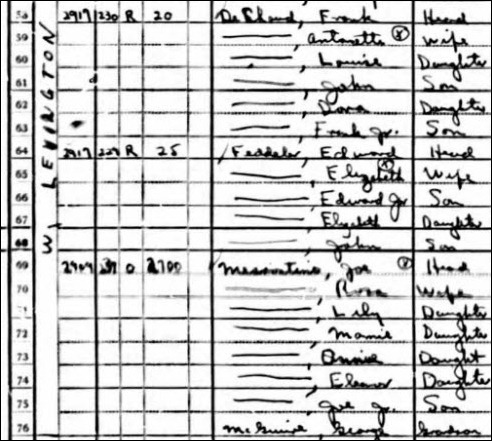The Scenario
Members of the Miserentino family are known to be at 2909 W. Lexington, Chicago, in 1930 and 1951, meaning they’re bound to be enumerated there in the 1940 census.
The Search
After locating the correct enumeration district (102-1599), a page-by-page search was conducted looking for the address 2909 W. Lexington. The residence was found on sheet 10A with two unknown families living there. The Miserentino family was not listed.

I almost gave up. But I KNEW they had to be there since I had placed them there on either side of 1940. Then in dawned on me…all those pages at the end of the enumeration district that seemed random, which I initially noticed when searching for names in a particular area (as opposed to an address) and further embedded in my brain from indexing these pages.
So on to the last page I went, working backward, looking again for 2909 W. Lexington (while also scanning the surnames). Bingo, on Sheet 63B, the family is listed at the Lexington address.

The Moral
You’ll notice that at the end of most enumeration districts, there is a hodgepodge of residences that are “out-of-order” by address and/or household number. In the above example, the order of households is 230, 228, 239. You should also note that on the sheet that is “in-order,” household 239 is missing (235, 236, 237, 238, 240). This is usually the indication you would need to prompt you in looking at the end of the ED for the missing household. Of course, the address you are looking for may be missing entirely from the “in-order” households because only one family (or household) resided there. Even if there aren’t any missing household numbers at or near the address you’re looking for, you should still check the end of the ED just to make sure.
This observation also means you should pay attention once the census is indexed. When you conduct a search using the index, it will take you to the page that the person is on. In this case, my search (hypothetically) for Joseph Miserentino would have brought me to Sheet 63B, which is in the “out-of-order” households. This means that if you find and “out-of-order” household, you should look back to the place where they would have been enumerated in sequence to see who else may have lived in the same house/building and who their neighbors were. If there is a household number in these “out-of-order” households, use that as your guide to finding the original sequence. Otherwise, start from the beginning of the ED and look for where the address would have occurred in sequence.

You are misinterpreting the end of the 1940 census sheets.
The enumerator was told to put families that were not home on his/her first sweep of the district, and for whom the enumerator left blank forms or made appointments to see the family later, …. to put these families starting on sheet number 61A. If you look at your ED, you will notice that there is a gap between the end of the first number sequences, and sheet 61A. You might also have some families on sheet 81A…. those are transients enumerated on April 8th and 9th, and found in flophouses, camps, hoovervilles, hotels, etc.
Joel Weintraub
Dana Point, CA
Thank you for your comment, Dana. I wasn’t misinterpreting this, I just didn’t explain it in detail. The point was to alert people to the fact that if they don’t find the family where expected, they could be in the batch at the end of the ED and they need to look there as well.
I didn’t know about the 81A though, so I appreciate that information. I had noticed it, and saw a few hotels and such at the very end, but didn’t realize there was a method to that scenario.